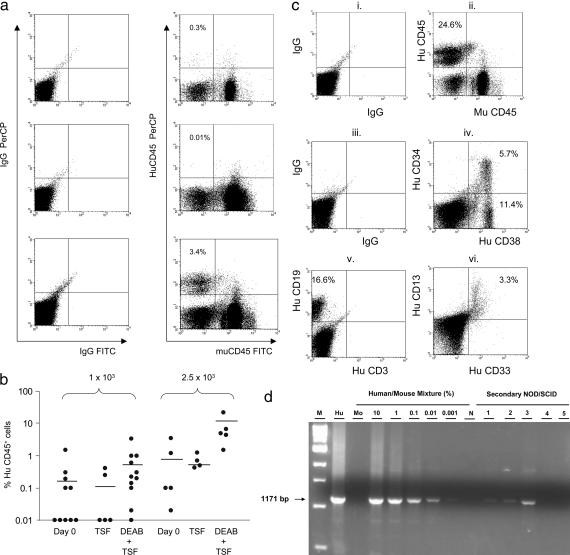Fig. 2.
DEAB treatment promotes the amplification of human SRCs. (a) Representative flow cytometric analysis of human CD45 versus murine CD45 surface staining in NOD/SCID mice is shown at week 8 in mice transplanted with 1 × 103 day 0 CB CD34+CD38−lin− cells (Top), their TSF-cultured progeny (Middle), or their progeny after DEAB + TSF culture (Bottom). (b) A scatter plot of human CD45+ cell engraftment in NOD/SCID mice at 8 weeks posttransplantation is shown with each individual point representing a single transplanted mouse. Mice transplanted with the progeny of CB CD34+CD38−lin− cells cultured with DEAB + TSF demonstrated significantly increased frequency of human engraftment (≥1.0%) and percent huCD45+ cell repopulation compared with day 0 CB CD34+CD38−lin− cells or their progeny after culture with TSF alone. The mean levels of huCD45+ cells per culture condition are indicated by horizontal lines. (c) Multilineage engraftment of CD45+ cells, CD34+ progenitor cells, CD19+ B cells, and CD33/13+ myeloid cells is shown in the BM of a representative NOD/SCID mouse transplanted with the progeny of 2.5 × 103 CB CD34+CD38−lin− cells after DEAB + TSF culture, demonstrating multilineage in vivo differentiation of DEAB treated cells. Shown are IgGPerCP versus IgGFITC control staining (i), huCD45 versus muCD45 staining (ii), IgGFITC versus IgG-phycoerythrin control staining (iii), huCD34 versus huCD38 staining (iv), huCD19 versus huCD3 staining (v), and huCD13 versus huCD33 staining (vi). (d) PCR analysis for a 1,171-bp segment of the human chromosome 17-specific α-satellite region demonstrates engraftment of human cells in secondary mice transplanted with BM cells from primary mice that had been transplanted with limiting dilutions of DEAB + TSF-cultured CB CD34+CD38−lin− cells. Human engraftment is evident at the 0.001–0.1% levels in three of the five mice analyzed. The label “M” represents a 1-kB DNA marker; “Hu” identifies 100% human CB cell DNA; “Mo” identifies 100% mouse BM cell DNA; and “N” identifies the no template control (dH20).

